Famous horse paintings like Whistlejacket (1762, George Stubbs), Napolean Crossing the Alps (1801, Jacquest-Louis David) and The Horse Fair (1855, Rosa Bonheur) are perfect for high-end interior decoration, and especially for anyone who is a horse lover.
From the moment humans were able to create art, horses have been a constant subject of representation, study, and fascination. From depictions of horses in battle, pulling horse-drawn vehicles, or in association with cowboys or Native Americans, horses have entered artwork throughout history (even in cave paintings) for a clear reason: for a long time, horses have influenced the human experience.
Below we’ll present the most famous horse paintings, along with key details and, of course, images!
Table of Contents
The 14 Most Famous Horse Paintings of All Time
| Painting Name (+ Link to Article Section) | Artist | Where You Can See It |
| Chinese Horse (Lascaux Cave Painting) | Unknown | Lascaux, Montignac, France |
| Whistlejacket | George Stubbs | The National Gallery, London, England |
| Horse Frightened by a Lion | George Stubbs | The Tate Gallery, London, England |
| Napoleon Crossing the Alps | Jacques-Louis David | Musée national du château de Malmaison, Rueil-Malmaison, France |
| The Horse Fair | Rosa Bonheur | The Metropolitan Museum of Art, New York City, USA |
| The 1821 Derby at Epsom | Théodore Géricault | The Louvre Museum, Paris, France |
| Horse Frightened by Lightning | Eugène Delacroix | Museum of Fine Arts, Budapest, Hungary |
| The Parade | Edgar Degas | Musée d’Orsay, Paris, France |
| Two Riders on the Beach | Max Liebermann | Private Collection |
| Blue Horse I | Franz Marc | Städtische Galerie im Lenbachhaus and Kunstbau, Munich, Germany |
| Blue Horses/Large Blue Horses | Franz Marc | Walker Art Center, Minneapolis, Minnesota |
| A Start at Newmarket | Sir Alfred Munnings | Private Collection |
| The Red Prince Mare | Sir Alfred Munnings | Private Collection |
| Grey Gelding | Lucian Freud | Private Collection |
The 3 Most Famous Horse Paintings
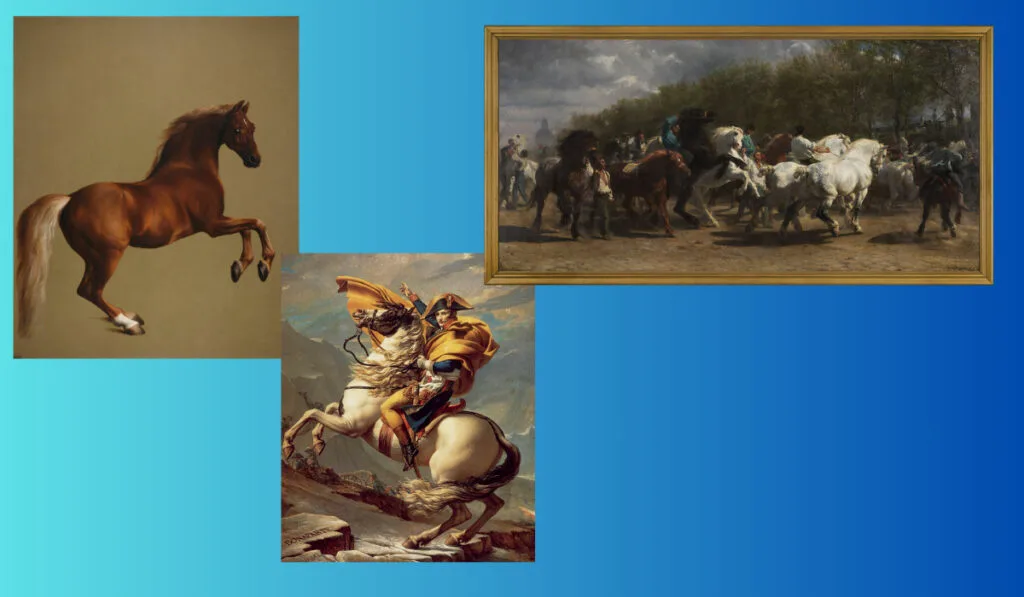
While personal preference varies, the three most famous horse paintings (presented left to right in the image above) are commonly agreed on as:
- Whistlejacket (1762, George Stubbs)
- Napolean Crossing the Alps (1801, Jacquest-Louis David)
- The Horse Fair (1855, Rosa Bonheur)
And before you head into the full details on the most famous horse paintings below, I’d encourage you to take a few minutes to watch this video in which Artist Deborah Butterfield discusses her process for making horse sculptures and how horses are presented in Art:
Chinese Horse (Lascaux Cave Painting)
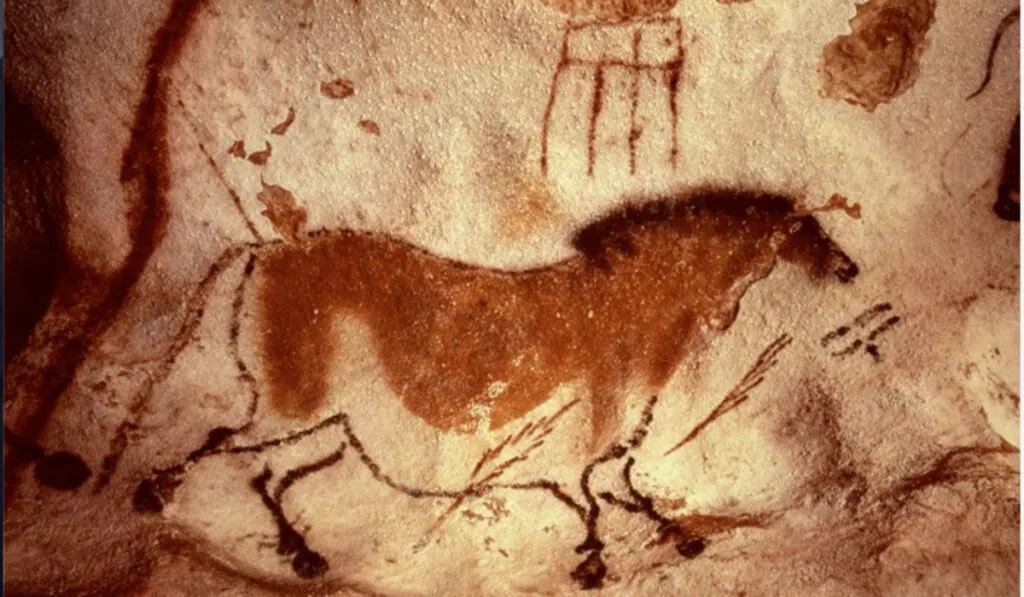
- Artist: Unknown
- Date: 15,000 to 13,000 B.C
- Medium: Minerals used as pigment on cave walls
- Estimated value: N/A
- Where you can see it: Lascaux, Montignac, France
The Chinese Horse, so named due to its resemblance to horses in the Chinese painting tradition, is one of the earliest representations of horses in art. Chinese Horse is a Paleolithic cave painting found in the caves at Lascaux, first discovered on September 12, 1940. The caves contain thousands of depictions of animals, human figures, and abstract forms.
The Lascaux caves were declared a UNESCO World Heritage Site in 1979 and were open to the public in 1948. In 1963, the caves had to be closed; the exhalations of the around 1,200 visitors entering the cave every day were causing irreversible damage to the paintings.
Nowadays, you can see a replica of this painting at Lascaux IV, a complete replica of the caves built in 2016 near the original site in Montignac, France.
Whistlejacket
- Artist: George Stubbs
- Date: 1762
- Medium: Oil on canvas
- Estimated value: $18 million (1997)
- Where you can see it: The National Gallery, London, England
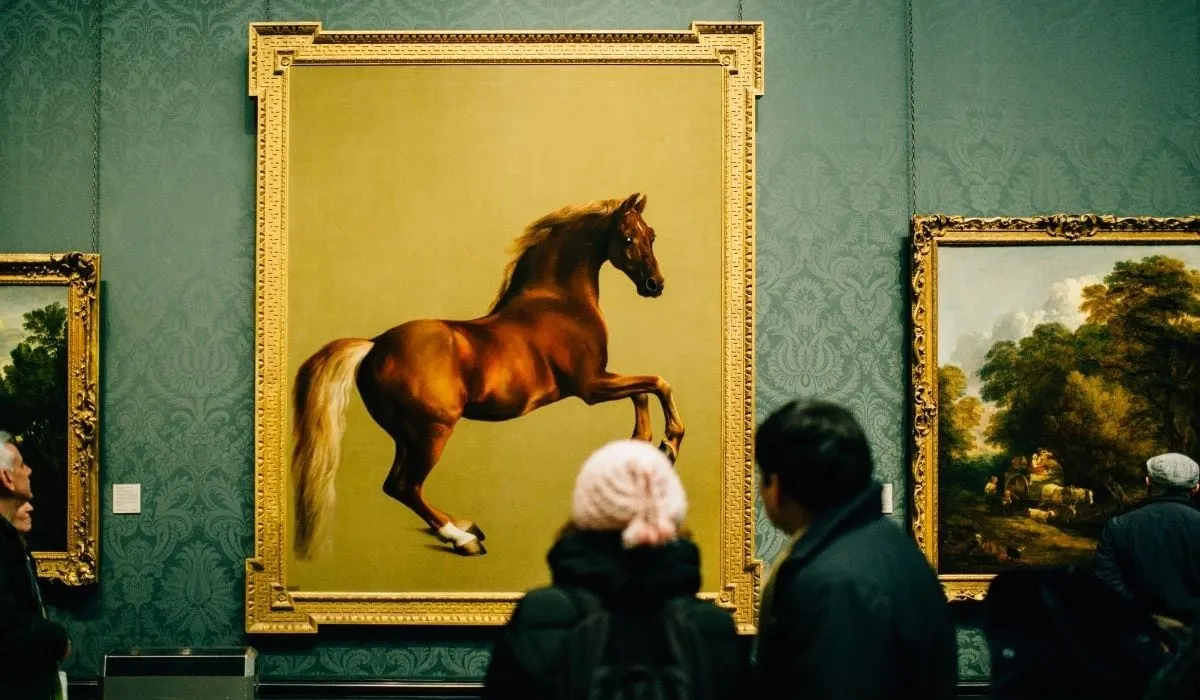
Whistlejacket is perhaps the most famous horse painting in art history. Measuring an incredible 115 by 97 inches, the painting is a portrait of real-life racehorse Whistlejacket.
Charles Watson-Wentworth, second Marquess of Rockingham, commissioned renowned English sports painter George Stubbs to do the magnificent portrait.
The most distinguishing characteristic of Whistlejacket is the fact that this famous racehorse is shown on its own, without any background, saddle, or bridle, which confers the painting a sense of freedom and majesty.
Stubbs’ masterpiece has also been praised by the way he captured the individuality and character of Whistlejacket, painting not just “a horse” but a specific horse with a real personality.
In 1997, the Rockingham family sold Whistlejacket to The National Gallery of London for £11 million, about $18 million.
Horse Frightened by a Lion
- Artist: George Stubbs
- Date: 1763
- Medium: Oil on canvas
- Estimated value: N/A
- Where you can see it: The Tate Gallery, London, England
As we have already seen in his portrait of racehorse Whistlejacket, English painter George Stubbs is considered to be one the most important horse painters in European art history, both due to his prolific contribution to the genre, and his mastery of the anatomy and spirit of the animal.
Horse Frightened by a Lion is one in a series of paintings by Stubbs representing the theme of the “horse and the lion,” and is considered to be one of a pair with Horse Devoured by a Lion, also from 1763, which shows the moment the lion has defeated the horse, its teeth already biting into the poor horse’s flanks.
In both paintings, Stubbs elevates the representation of the horse, transforming the animal into a heroic, noble figure.
Napoleon Crossing the Alps
- Artist: Jacques-Louis David
- Date: 1801
- Medium: Oil on canvas
- Estimated value: N/A
- Where you can see it: Musée national du château de Malmaison, Rueil-Malmaison, France
Napoleon Crossing the Alps, by the French painter Jacques-Louis David, is considered to be one of the best-known portraits of General and future emperor of France, Napoleon Bonaparte.
The painting commemorates Napoleon’s victorious military campaign against Austria in June 1800. The moment David chose to depict shows Napoleon leading his troops across the Alps in a majestic Arab stallion.
For this heroic equestrian portrait, David makes the horse as much a central figure in the painting as Napoleon himself. The exact moment depicted shows Napoleon pointing towards the summit on his rearing horse, the wind blowing both Napoleon’s hair and the horse’s mane.
And while Napoleon refused to sit for the portrait, he did provide David with instructions to paint him as “calm on a spirited horse.” It was all part of the myth-making aspect of portraiture painting. Another detail that wasn’t quite as accurate? Napoleon crossed the Alps on top of a mule, not a horse.
The Horse Fair
- Artist: Rosa Bonheur
- Date: 1853
- Medium: Oil on canvas
- Estimated value: $1.4 million
- Where you can see it: The Metropolitan Museum of Art, New York City, USA
Rosa Bonheur was one of the most well-known women painters of her time, having gained celebrity through her realistic portraits of animals, including bulls and horses.
To paint The Horse Fair, Rosa Bonheur prepared for a year and a half, attending the actual horse market twice a week to sketch. However, Bonheur soon found that it wasn’t an easy enterprise: she was constantly harassed for being a woman alone at the market.
Rosa Bonheur eventually obtained permission from the Paris police to be allowed to wear men’s clothes so she could focus on her work without attracting attention.
In 1887, after having passed through a few owners, American millionaire Cornelius Vanderbilt purchased the painting as a gift for the Metropolitan Museum. The purchase value of The Horse Fair in 1887 was $53,000 which in today’s dollars would represent over $1.4 million.
The 1821 Derby at Epsom
- Artist: Théodore Géricault
- Date: 1821
- Medium: Oil on canvas
- Estimated value: N/A
- Where you can see it: The Louvre Museum, Paris, France
French Romantic painter Théodore Géricault is best known for his 1819 painting The Raft of the Medusa, a work which caused shock and controversy when first exhibited at the Paris Salon due to its portrayal of the real-life event of the wreck of The Medusa, a French frigate carrying soldiers off the coast of Senegal.
What is less known is that Géricault was also a dedicated painter of horses, creating numerous sketches and paintings of animals throughout his career.
In 1821, during a year-long stay in England, Géricault was commissioned by horse merchant Adam Elmore to paint a racing scene. The result is The 1821 Derby at Epsom.
While the painting is famous for its dynamic depiction of four riders and their horses racing at full speed, the arrival of photography later in the century would prove that Géricault’s rendering of the horses with both front and hind legs extended in mid-air was inaccurate.
Some art historians suggest, however, that this may have been intentional: Géricault was merely imitating a particular English style of racing paintings of the period.
Horse Frightened by Lightning
- Artist: Eugène Delacroix
- Date: 1825-1829
- Medium: Watercolor
- Estimated value: N/A
- Where you can see it: Museum of Fine Arts, Budapest, Hungary
A leading figure of the French Romantic movement, Eugène Delacroix was a sought-after historical painter. This meant the artist was a proficient painter of horses, a common component of this genre of painting.
What differentiates Horse Frightened by Lightning from other paintings of the period is that similar to George Stubbs’s Whistlejacket, he has chosen to portray the horse on its own as the main subject of the picture.
The result is a work of great symbolic power, all centered around the figure of the horse, which, as the curators at the Budapest Museum of Fine Arts explain, becomes “all that the horse stood for in the eyes of the Romantics: power, nobility, untamed passion, and intensified emotions.”
The Parade
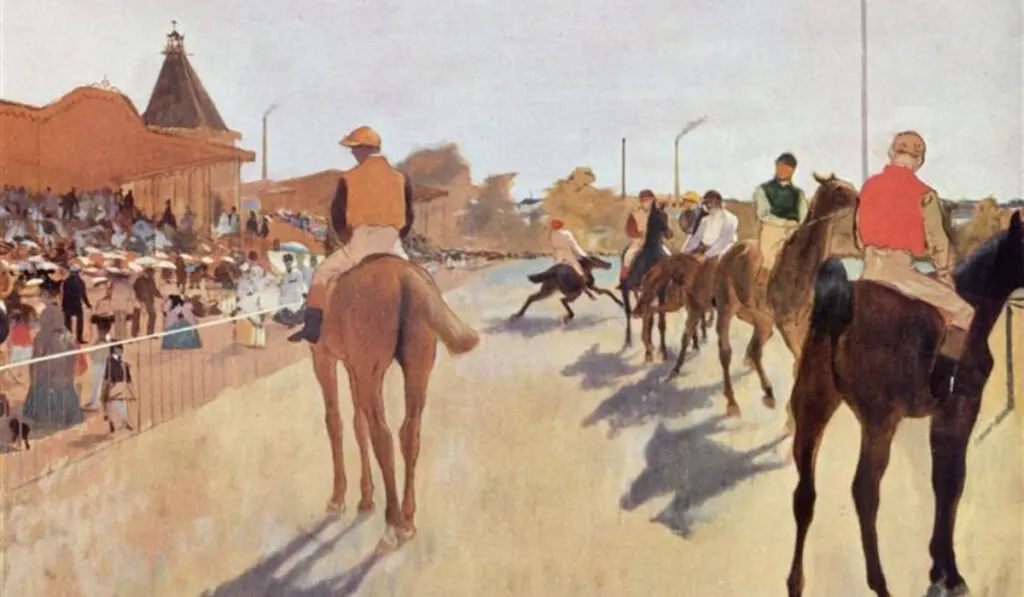
- Artist: Edgar Degas
- Date: 1866-1868
- Medium: Petrol painting on paper on canvas
- Estimated value: N/A
- Where you can see it: Musée d’Orsay, Paris, France
French Impressionist painter Edgar Degas is best known for his paintings of cafés, urban life, and most of all, dancers. What most art lovers may not know, is that Degas was also a prolific painter of horses, a subject matter he fell in love with after a visit to Normandy, a traditional horse breeding and horse racing region of France.
The Parade, also known as Race Horses in front of the Tribunes, shows a group of riders on their horses at the start of a race. The focus of the painting is on the colors, lights, and shadows of the scene to convey the excitement of the event.
Considered a sophisticated and exciting leisure activity, horse racing remained a popular subject in painting throughout the 19th century. Focused as he was on capturing modern urban life and all its leisure, horse races were a natural and frequent subject for Degas.
Two Riders on the Beach
- Artist: Max Liebermann
- Date: 1901
- Medium: Oil on canvas
- Estimated value: Sold for $2.9 million in 2015
- Where you can see it: Private collection
This extraordinary work is known both for its artistic merits as well as its tragic past.
Painted by German Impressionist painter Max Liebermann, Two Riders on the Beach was one of the thousands of paintings looted by the Nazis during World War II. In 2012, police in Germany raided the home of Cornelius Gurlitt, the son of Hildebrand Gurlitt, best known as “Hitler’s art dealer.”
The painting was restituted to the Liebermann family, who decided to sell it. Sotheby’s estimated the value of the painting at around $865,000. However, in 2015 a private buyer bought the painting for $2.9 million, three times the initial estimate.
Blue Horse I
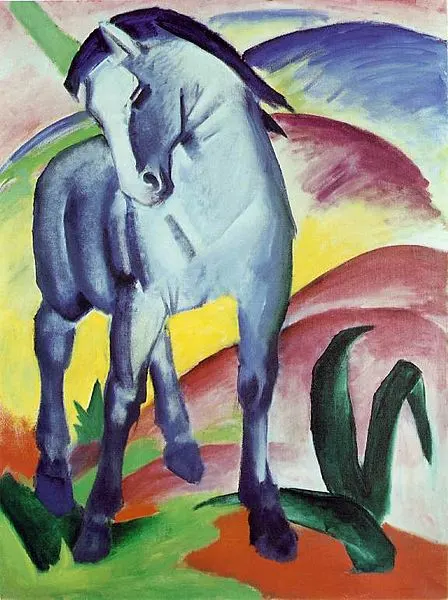
- Artist: Franz Marc
- Date: 1911
- Medium: Oil on canvas
- Estimated value: N/A
- Where you can see it: Städtische Galerie im Lenbachhaus and Kunstbau, Munich, Germany
Franz Marc was one of the leading figures of the German Expressionist art movement. He is known for the symbolism in his use of color and how he brought this sensibility to the paintings of animals, especially horses.
Blue Horse I, one of his most popular paintings, shows Franz Marc’s color symbolism in full: blue represented masculinity and spirituality, yellow, femininity, while red represented primal nature and violence in the world.
The horse in Blue Horse I brings together the nobility attributed to the horse to the spirituality of the blue to create an image that represents the triumph of spirituality over the material.
Blue Horses, aka Large Blue Horses
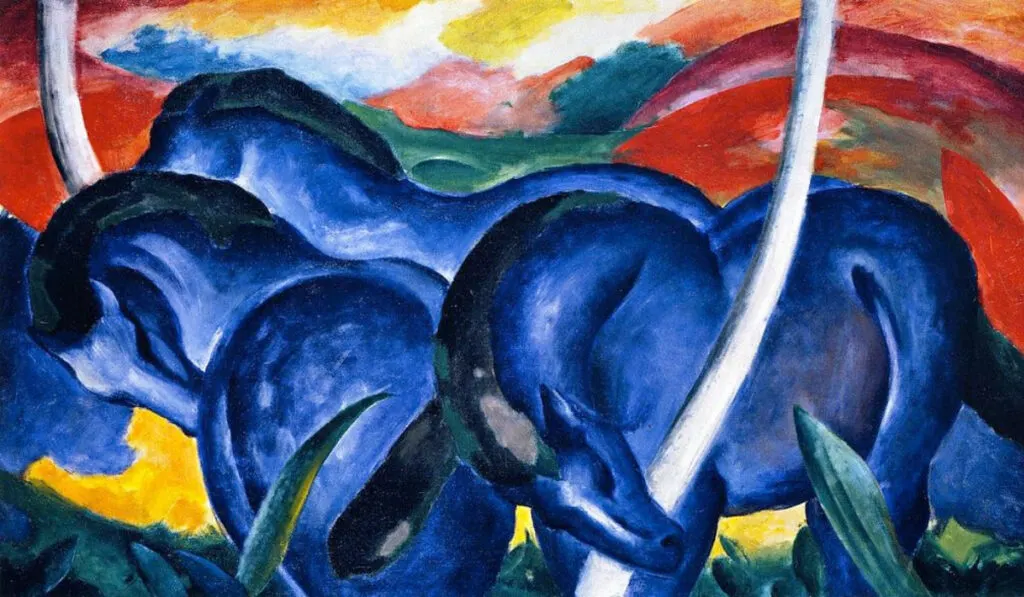
- Artist: Franz Marc
- Date: 1911
- Medium: Oil on canvas
- Estimated value: N/A
- Where you can see it: Walker Art Center, Minneapolis, Minnesota
Another beautiful blue Franz Marc piece makes the list, giving him two entries. Blue Horses, also sometimes referred to as Large Blue Horses, is another of his most popular paintings leaning more into the blue symbolism, and demonstrating the power of these animals.
A Start at Newmarket
- Artist: Sir Alfred Munnings
- Date: 1937
- Medium: Oil on panel
- Estimated value: $500,000 to $750,000
- Where you can see it: Private collection
British Impressionist painter Sir Alfred Munnings dedicated most of his artistic career to the painting of horses. Munnings grew up in a mill, in Suffolk, England, and spent his childhood sketching horses and the rural scenes that surrounded him.
A Start at Newmarket is one of Munnings’ many masterworks depicting horses at the races. In particular, Munnings was fascinated with the start of the race, as it allowed him to capture the nervous and contained energy of the horses and riders, and “epitomized the power and beauty of the horse, capturing the moment of stillness before the race begins.”
The Red Prince Mare
- Artist: Sir Alfred Munnings
- Date: 1921
- Medium: Oil on panel
- Estimated value: $7.8 million
- Where you can see it: Private collection
This imposing work, measuring 40 by 60 inches, depicts Rosemary, Sir Alfred Munnings’s wife’s mare. The scene Munnings chose to paint shows Rosemary being saddled before a race, and the work is known for its use of color to show the luminous coat of the mare against a crisp February sky.
The Red Prince Mare is not only considered a masterpiece of the genre, but it is also Munnings’s highest-priced painting ever. In 2004, while at auction at Sotheby’s, it sold for $7.8 million, almost double its initial estimated price.
Grey Gelding
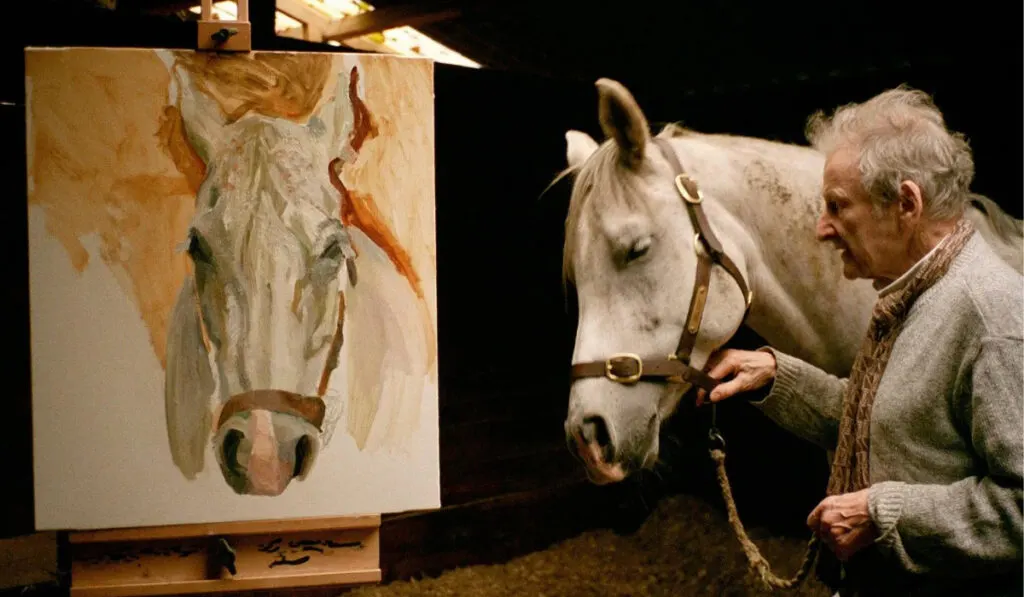
(Grey Gelding, 2003 © David Dawson—Courtesy of Hazlitt Holland-Hibbert)
- Artist: Lucian Freud
- Date: 2003
- Medium: Oil on canvas
- Estimated value: N/A
- Where you can see it: Private collection
Lucian Freud was a British artist who was predominantly known for his expressive portraits and self-portraits. He was born in Berlin and was the grandson of psychoanalyst Sigmund Freud. One of Freud’s most famous sitters is Queen Elizabeth II; he painted her portrait in 2001.
Freud was also a keen student of animals and many of Freud’s portraits present the sitter accompanied by their pets. Freud had a lifelong love of horses and in the early 2000s, he frequently visited the Wormwood Scrubs Pony Centre in London to ride and draw.
It was during that period that he painted the striking Grey Gelding portrait. Though the value of Grey Gelding has not been made public, a recently discovered incomplete sketch of a horse at the Centre is estimated to be worth between $50,000 and $75,000.
Frequently Asked Questions (FAQ):
Who is the most famous painter of horses?
The title of the most famous horse painting artist might arguably belong to George Stubbs (1724-1806), known for his exceptional and beautiful oil paintings of horses.
His artwork, such as “Whistlejacket,” is a stunning example of his skill in capturing the agile handling and grace of thoroughbred horses. Stubbs’ work of art is often considered crucial in the world of equine art, showcasing his remarkable talent and innovative approach.
What is the oldest painting of a horse?
The oldest known horse artwork is the “Chinese Horse” from the Lascaux Cave Paintings, dated between 15,000 to 13,000 B.C. This ancient and spectacular depiction showcases an early human connection with horses, providing vital insights into prehistoric art.
This old yet wonderful piece of history is outstanding not just for its age but also for the impressive skill and innovative techniques used by an unknown artist or artists, making it a famous artwork that has stood the test of time while retaining some mystery.
Related Reading
Resources
When learning about art history, it is important to consult a wide variety of sources. These are the sources used in this article.
- Tansey, Richard G., Kleiner, Fred S. Gardner’s Art Through the Ages, Tenth Edition. 1996.
- https://archeologie.culture.fr/lascaux/en
- https://www.youtube.com/watch?v=6M8BmsrC18g&t=324s
- https://www.theguardian.com/culture/2000/apr/22/art1
- https://www.tate.org.uk/art/artworks/stubbs-horse-frightened-by-a-lion-t06869
- https://www.tate.org.uk/art/artworks/stubbs-horse-devoured-by-a-lion-t02058
- https://www.khanacademy.org/humanities/renaissance-reformation/rococo-neoclassicism/neo-classicism/a/david-napoleon-crossing-the-alps
- https://www.jstor.org/stable/2929218?mag=napoleon-bonapartes-personal-brand&seq=1
- https://www.nationalgallery.org.uk/paintings/rosa-bonheur
- https://www.metmuseum.org/art/collection/search/435702
- https://www.nga.gov/collection/artist-info.1334.html?artobj_artistId=1334&sortOrder=TITLE&pageNumber=5&lastFacet=sortOrder#biography
- http://cartelfr.louvre.fr/cartelfr/visite?srv=car_not_frame&idNotice=15359
- https://books.google.ca/books?id=qz0sDwAAQBAJ&lpg=PR20&ots=X3Lk5IHGcK&dq=
- https://arthistoryland.com/eugene-delacroix-horse-frightened-by-lightning/
- https://www.mfab.hu/artworks/horse-frightened-by-lightning/
- http://www.visual-arts-cork.com/paintings-analysis/racehorses-in-front-of-the-stands.htm
- https://www.metmuseum.org/toah/hd/dgsp/hd_dgsp.htm
- https://www.dw.com/en/nazi-looted-painting-fetches-astonishing-price-at-sothebys/a-18539873
- https://www.britannica.com/biography/Franz-Marc
- https://www.lenbachhaus.de/en/discover/collection-online/detail/blaues-pferd-i-30019621
- https://www.christies.com/features/The-life-and-art-of-Sir-Alfred-Munnings-9538-1.aspx
- https://www.christies.com/lotfinder/paintings/sir-alfred-james-munnings-pra-rws-a-6246645-details.aspx?from=salesummery&intObjectID=6246645&sid=349d97ed-b0b5-4446-a96e-02a34cfa0ec1
- https://www.sothebys.com/en/auctions/ecatalogue/2004/property-of-the-greentree-foundation-from-the-collection-of-mr-and-mrs-john-hay-whitney-impressionist-and-modern-art-n07989/lot.30.html
- https://www.wikiart.org/en/lucian-freud/grey-gelding
- https://artdaily.cc/news/117923/Recently-discovered-sketch-by-the-artist-Lucian-Freud-to-go-up-for-auction-in-London-#.Xwi8vojYrrc
- https://archeologie.culture.gouv.fr/lascaux/en/lascaux-iv
- https://www.jstor.org/stable/2929218?mag=napoleon-bonapartes-personal-brand&seq=3#metadata_info_tab_contents
- https://collections.louvre.fr/ark:/53355/cl010064852
- https://www.mfab.hu/artworks/11165/
- https://en.wikipedia.org/wiki/Blue_Horses
- https://www.wikiart.org/en/lucian-freud
- https://www.nationalgallery.org.uk/artists/george-stubbs
- https://www.bradshawfoundation.com/lascaux/

